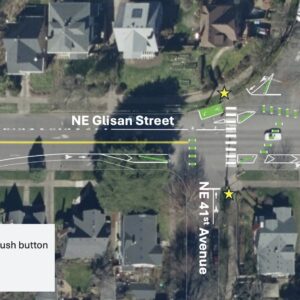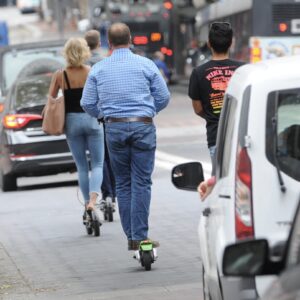A $160 million renovation of University of Oregon’s Erb Memorial Student Union (EMU) will include a new, 5,000 square foot ‘Bike Center’ that will include retail and repair services, secure bike parking, showers, locker space and more. The project shows UO’s response to the growing demand for bicycling at the Eugene campus where 17 percent of students ride.
UO’s Bike Program is currently housed on the edge of campus in a cramped space dubbed “the barn.” EMU Bike Center Project Coordinator Briana Orr, who helped start UO’s Bike Program in 2008, told me today that the EMU Bike Center is modeled after Portland State University’s Bike Hub. “It’s best model we’ve seen.”
Orr says the move to the EMU is also a major step for the Bike Program and for bicycling at the university in general. “Having our own space and professional staff means we’ll feel a bit more legitimate.”
Once up and running the UO Bike Program budget will go from $26,000 a year to $100,000 a year. Orr says about half that new budget will come from revenue generated by the shop.
Why should a university prioritize bicycling and offer top-notch facilities? It’s simple economics, as Orr laid out in the Bike Center proposal:
“Dollar for dollar, bicycling infrastructure costs less than auto or mass transit infrastructure per user.i Bicycling is not only economically sensible for the institution, it is economically sensible for students. Providing the least expensive transportation options will help those financially struggling to attend college.”








Thanks for reading.
BikePortland has served this community with independent community journalism since 2005. We rely on subscriptions from readers like you to survive. Your financial support is vital in keeping this valuable resource alive and well.
Please subscribe today to strengthen and expand our work.
…if the students vote to fund the renovations.
The university wants to tax current students hundreds of dollars a year to pay for this future facility. (http://referendum.uoregon.edu/faq/)
The university has always used this model. The students that paid the fees 15 years ago created the current version of the SRC, the students that attend 15 years from now will pay for the next version. Don’t forget all the benefits the students get *they* didn’t pay for. The bike shop/hub is a pretty small aspect of this change and one that I think is well needed. There are plenty of bike shops in Eugene, but what is more local than using the university bike shop while at the university!
Sounds like a good place to sit down and have a tea with the professor of bike psychology
So much for supporting local retailers.
Is Eugene bereft of bicycle shops?
As a UO employee, I’d be super excited about it – but yeah, I can understand why students wouldn’t be too excited about paying $60-100 per term for a renovation that they may never get to use.
It might be cheaper to use student funds to hire development staff to collect money from rich people – that certainly seems to work elsewhere on campus.
It could be the Gary Fisher Bike Center.
Parking is a ridiculous money loser for universities. I wonder what would happen if the people in charge tripled the price students and staff pay for parking and put all of the new revenue into bike infrastructure. is that sort of thing subject to a vote?
I wonder if the UO actually does lose money on parking…. there isn’t a lot of expensive parking infrastructure here, and they hugely oversell the lots.
I always find the BTA challenge statistics a little bit laughable, since obviously the team of “over 100 riders” is nowhere near the number of people who are actually riding to campus every day.
Where did the 17% for students come from? is there a number for staff/faculty?
Glad to see some discussion regarding the Bike Center. The 17% figure comes from our Office of Sustainability, who puts out a transportation survey every three years. This figure is from 2009, and campus has been increasing bike parking all over campus due to demand since then. 15% of faculty and staff ride to campus.
The last survey results can be found in the 2009 Office of Sustainability Newsletter: http://sustainability.uoregon.edu/office-sustainability/newsletters